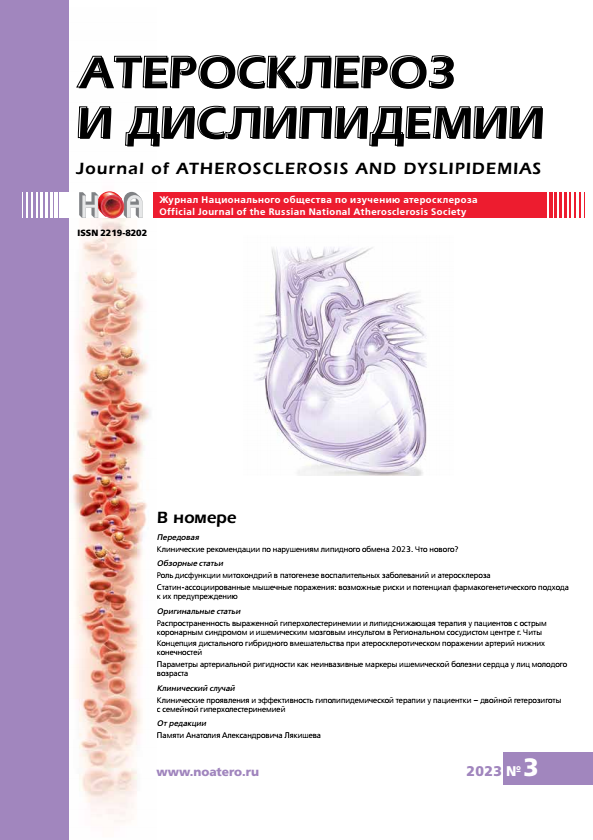Концепция дистального гибридного вмешательства при атеросклеротическом поражении артерий нижних конечностей
DOI:
https://doi.org/10.34687/2219-8202.JAD.2023.03.0005Аннотация
Патогенетически обоснованное оперативное лечение критической ишемии нижних конечностей, вызванной окклюзией поверхностной бедренной артерии при ее атеросклеротическом поражении, остается проблемой в современной сосудистой хирургии. После открытых реконструкций возникает существенный риск тромбозов и инфекционных осложнений. При интервенционных оперативных вмешательствах затруднительно получить хорошие результаты при множественных и протяжённых окклюзирующих поражениях.
В связи с этим ведется поиск новых подходов к оперативному патогенетически обоснованному лечению атеросклеротического поражения нижних конечностей. В статье предлагется концепция примененияч дистального гибрида, как универсального решения клинических случаев с различными морфологиями критической ишемии нижних конечностей. Доказательной базой послужили множественные научные публикации по данной тематике, а также исследования, выполненные на базе городского центра спасения конечностей ГБ № 14. Выполнен сравнительный анализ немедленных и отсроченных результатов операций согласно концепции дистального гибрида с другими методами.
Скачивания
Библиографические ссылки
Walden R, Adar R, Rubinstein ZJ, et al. Distribution and symmetry of arteriosclerotic lesions of the lower extremities: an arteriographic study of 200 limbs. Cardiovasc Intervent Radiol. 1985;8(4):180-2. J Vasc Surg. 2010;51(5 Suppl):32S-42S.
Narula N, Dannenberg AJ, Olin JW, et al. Pathology of peripheral artery disease in patients with critical limb ischemia. J Am Coll Cardiol. 2018;72(18):2152-2163.
Chung J, Modrall JG, Knowles M, et al. Arteriographic patterns of atherosclerosis and the association between diabetes mellitus and ethnicity in chronic critical limb ischemia. Ann Vasc Surg. 2017;40:198-205.
Rueda CA, Nehler MR, Perry DJ, et al. Patterns of artery disease in 450 patients undergoing revascularization for critical limb ischemia: implications for clinical trial design. J Vasc Surg. 2008;47(5):995-9.
Bradbury AW, Adam DJ, Bell J, et al. Bypass versus Angioplasty in Severe Ischaemia of the Leg (BASIL) trial: A description of the severity and extent of disease using the Bollinger angiogram scoring method and the TransAtlantic Inter-Society Consensus II classification. J Vasc Surg. 2010;51(5 Suppl):32S-42S.
Blair JM, Gewertz BL, Moosa H, et al. Percutaneous transluminal angioplasty versus surgery for limb-threatening ischemia. J Vasc Surg. 1989;9(5):698-703.
Palena LM, Diaz-Sandoval LJ, Sultato E, et al. Feasibility and 1-year outcomes of subintimal revascularization with Supera® stenting of long femoropopliteal occlusions in critical limb ischemia: the “Supersub” study. Catheter Cardiovasc Interv. 2017;89(5):910-920.
Davies MG, Saad WE, Peden EK, et al. Impact of runoff on superficial femoral artery endoluminal interventions for rest pain and tissue loss. J Vasc Surg. 2008;48(3):619-25.
Ah Chong AK, Tan CB, Wong MW, et al. Bypass surgery or percutaneous transluminal angioplasty to treat critical lower limb ischaemia due to infrainguinal arterial occlusive disease? Hong Kong Med J. 2009;15(4):249-54.
Moxey PW, Hofman D, Hinchliffe RJ, et al. Trends and outcomes after surgical lower limb revascularization in England. Br J Surg. 2011;98(10):1373-82.
Romiti M, Albers M, Brochado-Neto FC, et al. Meta-analysis of infrapopliteal angioplasty for chronic critical limb ischemia. J Vasc Surg. 2008;47(5):975-981.
Cotroneo AR, Iezzi R, Marano G et al: Hybrid therapy in patients with complex peripheral multifocal steno-obstructive vascular disease: two-year results. Cardiovasc Intervent Radiol 2007;30:355–361.
Zhou M, Huang D, Liu C, et al. Comparison of hybrid procedure and open surgical revascularization for multilevel infrainguinal arterial occlusive disease. Clin Interv Aging. 2014;9:1595-603.
Conte MS, Bradbury AW, Kolh P, et al. Global vascular guidelines on the management of chronic limb-threatening ischemia. Eur J Vasc Endovasc Surg. 2019;58(1S):S1-S109.
Toursarkissian B, D’Ayala M, Stefanidis D, et al. Angiographic scoring of vascular occlusive disease in the diabetic foot: relevance to bypass graft patency and limb salvage. J Vasc Surg. 2002;35(3):494-500.
Gruss JD, Heimer W. Results of femoropopliteal and femorotibial greater saphenous vein in situ bypass. Life table analysis. Int Angiol. 1992;11(2):94-105.
Heimer W, Uy J, Geissler C, et al. Femoropopliteal and femorotibial greater saphenous vein “in situ” reconstructions in non selected patients. Life table analysis. J Cardiovasc Surg (Torino). 1993;34(4):303-5.
Iida O, Takahara M, Soga Y, et al. Impact of angiosome-oriented revascularization on clinical outcomes in critical limb ischemia patients without concurrent wound infection and diabetes. J Endovasc Ther. 2014;21(5):607-15.
Alexandrescu VA, Brochier S, Limgba A, et al. Healing of diabetic neuroischemic foot wounds with vs without wound-targeted revascularization: preliminary observations from an 8-year prospective dual-center registry. J Endovasc Ther. 2020;27(1):20-30.
Mannick JA, Jackson BT, Coffman JD, et al. Success of bypass vein grafts in patients with isolated popliteal artery segments. Surgery. 1967;61(1):17-25.
Загрузки
Опубликован
Как цитировать
Выпуск
Раздел
Лицензия
Copyright (c) 2023 A. A. Кучай, А. Н. Липин , П. С. Курьянов, Н. Н. Груздев, К. А. Атмадзас, Н. Р. Карелина , Л. Ю. Артюх

Это произведение доступно по лицензии Creative Commons «Attribution» («Атрибуция») 4.0 Всемирная.























